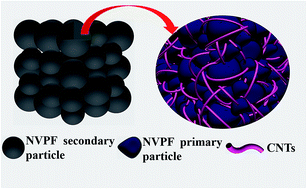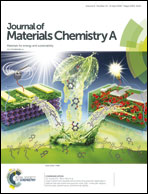Na3V2(PO4)2F3@C dispersed within carbon nanotube frameworks as a high tap density cathode for high-performance sodium-ion batteries†
Abstract
Currently, the sodium-ion battery is one of the hottest topics in the field of battery research. For practical application, however, high tap density, which is a key point of electrode materials, has always been ignored in previous studies. Here, we present the fabrication of a NASICON-type Na3V2(PO4)2F3@C/CNT composite cathode with a high tap density of 1.2 g cm−3 for high power and long lifespan sodium-ion batteries. The spherical NVPF@C/CNTs synthesized through a spray drying method are composed of micron-sized primary particles dispersed within the intertwined carbon nanotube matrix. The CNT framework not only provides an efficient electrical highway between primary particles, but also forms a stable mechanical backbone for secondary particles. The initial discharge capacity of NVPF@C/CNTs is about 113 mA h g−1 at a current density of 1C, and the cell retains 98.2% after 300 cycles. Besides, a high rate capacity of 85 mA h g−1 has been achieved at 30C. We believe that our work presented here will be favorable for accelerating the commercialization of sodium-ion batteries.



 Please wait while we load your content...
Please wait while we load your content...